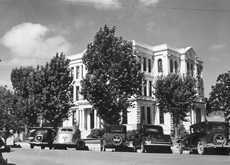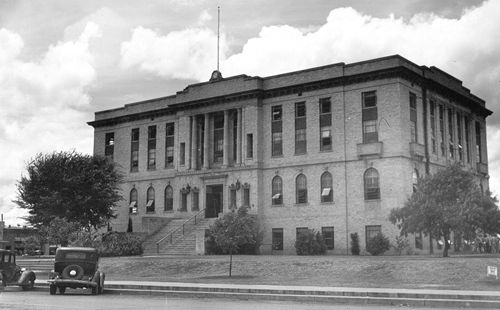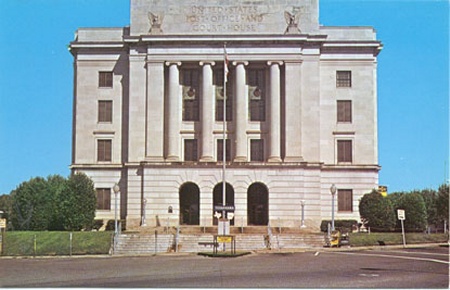Membership in the American Society of Trial Consultants gives access to a collegial email list where members are able to ask questions and share experiences. This week a discussion began on rural courthouses without metal detectors even in this post 9-11 era. As members began to share their experiences in these courtrooms time forgot, it seemed a good opportunity for us to tell these stories to you as well.
Return the favor! If your travels have taken you to rural courthouses time has forgotten–share them with us in the comments section. It’s a departure for The Jury Expert to swap stories–but we thought these were good stories to swap.
Doug Keene, Keene Trial Consulting
This week I had a special, nostalgic experience. I drove northeast from Austin, into the farming country that covers most of the east-central part of Texas, through counties where farm animals greatly outnumber people. At the end of the drive I pulled up to a parking space in the town square, walked 50 feet up a sidewalk, and entered a courthouse built in 1892. I walked up the stairs and entered a courtroom that truly could have served as the movie set for “To Kill a Mockingbird”. And I did it without going through a metal detector.
 According to a recent research post on https://arcules.com/, a lot of city folks don’t realize that there are actually a good number of courthouses that don’t have any security other than a bailiff that frankly looks like a Wal-Mart greeter. I thought it would be sort of interesting to see how many of us practice in venues where they employ the same security that they used in 1970. This week it was Milam County, Texas (Cameron), but not long ago it was Fort Bend County (Richmond).
According to a recent research post on https://arcules.com/, a lot of city folks don’t realize that there are actually a good number of courthouses that don’t have any security other than a bailiff that frankly looks like a Wal-Mart greeter. I thought it would be sort of interesting to see how many of us practice in venues where they employ the same security that they used in 1970. This week it was Milam County, Texas (Cameron), but not long ago it was Fort Bend County (Richmond).
Where in the heartland have you gone without passing through a metal detector?
Zoe Oakleaf, Opinion Research Associates, Inc.
I AM NOT MAKING THIS UP.
In 2006 I had some press releases to give to journalists at the Louisiana State Capitol in Baton Rouge. (We had done a poll showing support for making the state smoke free.) I entered through the ground floor of the capitol building and never went through a metal detector.
Remember this is THE SAME BUILDING where Governor Huey Long was assassinated in the 1930s. The bullet holes are still in the wall.
Dan Dugan, Trial Science, Inc.
Minden, Nevada. July, 2009. They have a metal detector and one officer to staff it, but when I returned from lunch during a jury selection day, I was in the parking lot getting my computer in its case to take in.
I saw three men in rather ragged clothing taking uncased rifles out of their trunk. They walk over to another car where three more men in similar garb get out and get more rifles out of their trunk. I stay in my car. The six gunmen start walking around to the side of the courthouse.
With a bigger than HUGE lump in my throat I jump out of my car and make a beeline for the front door, waving at the lone security officer. I tell him my observation between gasps for air. He calmly responds, “we have the county and regional firing range in the basement. Those were DEA agents coming in for their shooting certifications.”
So, for the rest of the afternoon, I felt my feet burning on the floor, hoping none of the agents pointed one of those guns up toward their ceiling/my floor.
David B. Graeven, Trial Behavior Consulting
In a capital case in Southern Ohio I was involved in responding to a transfer of venue motion involving the killing of a police officer. This was the one time I have been retained to oppose transfer. While the hearing on the motion was going, on I was told to remain in the hallway.
There was only one courtroom and it was mid-August, no air conditioning. As the day went on, the family of the defendant kept going in and out of the courthouse to smoke and, although there was a metal detector, the check in procedures became more lax. The women would pass their purses outside the metal detector.
I stood on the bench to see what they were doing outside and saw the five family members gathered around their truck and they saw me watching them. They didn’t seem happy and gave me the evil eye. There was no way out of the hallway. It seemed suspicious to me. I became more concerned and told the bailiff to check the bags. In hindsight I do not regret that decision.
The next week the defendant escaped from the County Jail ( the jail yard was a cyclone fence with barbed wire) and it was believed his family members assisted. He joined the list of America’s Most Wanted and was featured in that show. He was eventually caught living in the woods, pled guilty and was given a life sentence.

Tara Trask, Tara Trask and Associates
Burleson County, TX. Beautiful courthouse in the center of town the way many of those old courthouses are situated. No metal detector–many doors and you could come in through any one you chose. Interestingly, the court reporter is married to the bailiff and they ride to work together every day.
This courthouse used to be like the one Doug describes…. something out of Inherit the Wind or To Kill a Mockingbird, but alas someone decided to remodel the inside in the seventies (complete with wood paneling over some of the upstairs windows), and the interior is the worse for it. The staff said it does help keep it cool since they put air conditioning in.
Tara Trask, Tara Trask and Associates
I should note that my own home courthouse of Marin County California does not have metal detectors. Although Marin is largely protected open space, it can hardly be considered rural, both considering its population (250,000) and its close proximity to San Francisco (a few miles).
It’s particularly interesting that Marin County’s courthouse does not have metal detectors given its history. It was designed by Frank Lloyd Wright and was a partial inspiration for Lucas’s Star Wars locations.
More importantly, in 1970, the courthouse was the scene of an attack by African American political activists led by Jonathan Jackson, brother of Black Panther leader George Jackson. They demanded the release of the “Soledad Brothers”. Multiple people, including presiding Judge Haley were taken hostage. During the escape, four people, including Johnson and Haley were killed.
It is my understanding that the only other judge to be killed in a courthouse was the shooting in Atlanta in 2005. I’ve always thought it strange that the Marin Courthouse, of all the courthouses in America, has no metal detectors.
Sharon Lundgren, Lundgren Trial Consulting
This is on the opposite side of the spectrum – the Federal Courthouse in Texarkana has very good security and a metal detector. But it is an interesting courthouse because the State Line runs right up the center of the building, so you chose whether to go through the door on the Texas side or the Arkansas side. It also has a post office on the Texas side of the building and another on the Arkansas side.

The security was rather good and somewhat intimidating. The Federal agents look you directly in the eye and ask you exactly where you are going, and why (perhaps because folks wanting to go up to the Arkansas courtrooms and Texas courtrooms go in the wrong door). Once you are upstairs, however, you simply walk across the hall to the other state’s courtrooms. So we went up the elevator in Texas and came down the elevator in Arkansas.
(I have a photo of the building with the state line if anyone is interested).
Katherine James, Act of Communication
I believe I must have worked on THE case that made metal detectors a common sight in Texas courthouses today.
It was the summer of 1995 in Bay City, Texas. A civil case that took 10 months to try – so you can imagine that every day pretty much was a slow news day at the courthouse. Yet there was enough money on the line — 3 billion dollars — to warrant the press keeping tabs on what was going on. No news for the reporters day after day after day — until the day that the bailiff dropped his gun in the courtroom. BAM! WHAM!
No one was hurt – but the bullets did ricochet around. News Flash! At last there was something to report! When the AP press service picked up the story and it was simply EVERYWHERE within hours, the judge took the gun away from the bailiff.
The poor guy (who never DID figure out who I was and what I did in the trial) was quite chagrined. I’m not saying he was the brightest bulb on the tree, but he did take pride in that badge, uniform and weapon. I don’t know if he ever got it back. If he did, I can definitely see the reason to make sure that he couldn’t sneak it back into the Courthouse.
But I couldn’t help but notice that after that there were metal detectors all over the State of Texas.
I’M JUST SAYIN’.
Lucy M. Keele, Keele Litigation Support Services, Inc.
Tuskegee, Alabama. Old, red brick courthouse facing town square. Law office was on another side of the same square. We are talking rural! HUGE case that occasioned the judge to remark that “this is the case of a lifetime for me”. Out of town reporters. I could almost see Gregory Peck.
Well, as many cases do, it settled during jury selection, and the judge was so disappointed because he had already called relatives in San Francisco to alert them to “watch the news”. He came to the hotel the following morning to personally say goodbye to all attorneys and consultants. It was really quite charming.
If these stories from ASTC-member consultants bring to mind tales of your own–share them with us in the Comment box below.